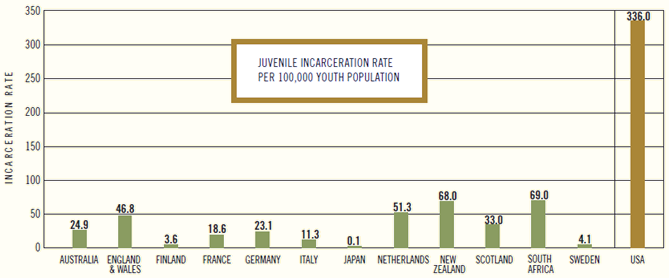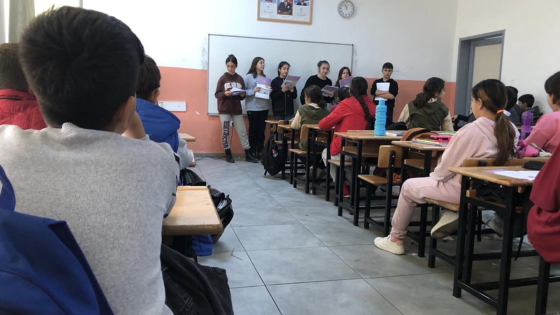The US incarcerates juveniles at a much higher rate than other nations.
- It spends some $6 billion per year on juvenile corrections (see Figure 1 from Mendel 2011).
- In fact, on any given day, there are over 70,000 juveniles in custody in the US (OJJDP 2011) with an average (direct) cost of $88,000 per juvenile per year.
Figure 1. Youth incarceration rate: US versus other nations
Source: Hazel, Neal, Cross-National Comparison of Youth Justice, London: Youth Justice Board, 2008).
Despite such high rates and the associated direct costs, little is known about the impact of incarcerating juveniles on their long-term outcomes such as educational attainment and the likelihood of further offenses as an adult. On the one hand, incarceration at an early age might serve to reduce future criminal activity by making the cost of later incarceration more salient. On the other hand, incarceration during adolescence may interrupt human and social capital accumulation at a critical moment leading to reduced future wages in the legal sector and greater criminal activity (Becker 1968).
The lack of existing empirical work on this topic is due to two main factors:
- First, estimation is complicated by the fact that juveniles who are incarcerated differ from those who are not.
They have likely committed more serious crimes, their background may be more disadvantaged, and as a result their underlying propensity to drop out of school and commit a crime in the future may be higher than that of juveniles who were not committed. Unfortunately, it is difficult to control for these confounding factors that tend to overstate the effects of juvenile incarceration on the propensity to drop out of high school or become incarcerated as an adult.
- A second complicating factor is the dearth of data that includes information on juvenile incarceration and long-term outcomes.
Survey data is generally insufficient to estimate the impact of juvenile incarceration on future outcomes because few survey respondents would have spent time in juvenile detention as a youth and there is underreporting of criminal activity and incarceration. In the observational studies that have been conducted, De Li (1999), Tanner et al. (1999) and Sweeten (2006) find that juvenile incarceration is correlated with a higher likelihood of dropping out of high school. Hjalmarsson (2008) also finds such effects when comparing siblings, although the results apply to a small number of households.
New research
In a recent paper, we tested which of the two potential effects of juvenile incarceration dominates by examining empirically how incarceration as a juvenile influences high school completion – a partial measure of social and human capital formation – and the likelihood of incarceration later in life (Aizer and Doyle 2013).
- To address the first complicating factor we exploit the random assignment of cases to judges who vary in their sentencing.
Specifically, we examine the outcomes of juveniles who are very similar based on their observable characteristics (same age, race, crime, and neighbourhood) but who by chance are assigned to judges who differ in their sentencing severity. In this way, we can compare the outcomes of two identical (or near identical) juveniles, one of whom, by virtue of random assignment to a ‘stricter’ judge, is incarcerated and one of whom, by virtue of assignment to a more ‘lenient’ judge, is not. With this strategy we address the issue of negative selection into juvenile incarceration.
- Second, we do not use survey data, but rather a unique source of linked administrative data for over 35,000 juveniles over ten years who came before a juvenile court in Chicago, Illinois.
These data were linked to both public-school data for the same city and adult-incarceration data for the same state to investigate effects of juvenile incarceration on high-school completion and adult imprisonment.
Juvenile incarceration means worse grades and more criminality in the future
We find that juvenile incarceration reduces the probability of high school completion and increases the probability of incarceration later in life. While some of this relationship reflects omitted variables (as described above), even when we control for potential confounding factors using random assignment to judges, the relationships remain strong. In regressions with minimal controls, those incarcerated as a juvenile are 39 percentage points less likely to graduate from high school and are 41 percentage points more likely to have entered adult prison by age 25 compared with other public school students from the same neighbourhood. Once we include demographic controls, limit our comparison group to juveniles charged with a crime in court but not incarcerated, and exploit random assignment to judges, juvenile incarceration is estimated to decrease high school graduation by 13 percentage points and increase adult incarceration by 22 percentage points. The results, while smaller than the initial results, remain large and suggest substantial negative effects of juvenile incarceration on long-term outcomes.
Conclusions
Our results suggest that incarcerating juveniles, at tremendous cost, serves to reduce their educational attainment and increase the probability of incarceration as an adult. Interestingly, after years of steady increases in juvenile incarceration, in the past decade, juvenile incarceration has started to decline.
- Nationally, juvenile incarceration has dropped 32% from 2002 to the present (National Juvenile Justice Network 2013).
- This is driven by both falling rates of crime and by concerted efforts on the part of roughly ten (of the largest) states to reduce expenditures on juvenile incarceration by substituting to less costly community-based alternatives.
This trend extends to Chicago which has more alternatives to incarceration now than it did when many of the subjects were being sentenced in the early 1990s.
- The evidence presented here suggests that shifting to such alternatives will likely not only save the states money in the short run, but also reduce future crime and thus expenditures on corrections in the long run.
Whether this trend of reductions in rates of juvenile incarceration will continue, however, is not clear. The New York City School Justice Partnership Task Force refers to the recent development of a ‘school-to-prison pipeline’ whereby students involved in relatively minor infractions are increasingly likely to be arrested. Again the evidence presented here suggests that policies or practices putting more juveniles in detention are likely to have high short and long-term costs.
References
Aizer, A and J J Doyle Jr (2013), “Juvenile Incarceration, Human Capital and Future Crime: Evidence from Randomly-Assigned Judges”, NBER Working Paper, 19102, available at .
Becker, G (1968), “Crime and Punishment: An Economic Approach”, Journal of Political Economy 76, 169-217.
De Li, S (1999), “Legal Sanctions and Youths' Status Achievement: A Longitudinal Study”, Justice Quarterly 16, 377-401.
Hazel, N (2008), “Cross-National Comparison of Youth Justice”, London, Youth Justice Board for England and Wales.
Hjalmarsson, R (2008), “Criminal Justice Involvement and High School Completion”, Journal of Urban Economics 63: 613-630.
Mendel, R A (2011), “No Place for Kids: The Case for Reducing Juvenile Incarceration”, Baltimore, The Annie E Casey Foundation.
National Juvenile Justice Network and the Texas Public Policy Foundation (2013), “The Comeback States: Reducing youth incarceration in the US” in The New York City School Justice Partnership Task Force, “Keeping Kids in School and Out of Court”.
Office of Juvenile Justice and Delinquency Prevention (2011), “Census of Juveniles in Residential Placement 2010”, Washington, DC, OJJDP.
Sweeten, G (2006), “Who Will Graduate? Disruption of High School Education by Arrest and Court Involvement”, Justice Quarterly 23, 462-480.
Tanner, J, S Davies and B O'Grady (1999), “Whatever Happened to Yesterday's Rebels? Longitudinal Effects of Youth Delinquency on Education and Employment”, Social Problems 46, 250-274.



